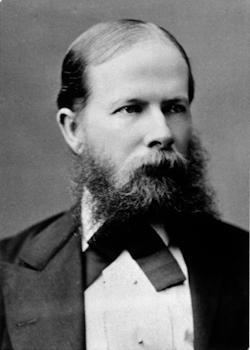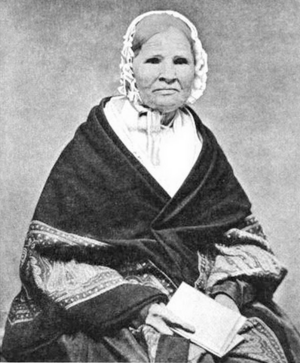Women's suffrage in Wyoming facts for kids
Wyoming was the first place in the world to give all women the right to vote! This happened when Wyoming was a U.S. territory in 1869. The first group of lawmakers there, who were all men, voted to give women the right to vote and even hold public office.
This important law was called "An Act to Grant to the Women of Wyoming Territory the Right of Suffrage, and to Hold Office." Even when Wyoming wanted to become a state, and some people worried this law might stop it, the territory kept its woman suffrage law. In 1890, Wyoming officially became the first U.S. state where women could vote.
Contents
How Did Wyoming Lead the Way?
The idea of women voting started gaining traction when Wyoming was still part of the Dakota Territory. In 1867, many people moved to the area because the Union Pacific Railroad was being built and gold was found near South Pass.
Wyoming Territory was created south of these gold rush mountains. The new territory included South Pass, a famous crossing point over the Continental Divide. Early mining towns like South Pass City grew quickly. At first, miners weren't interested in setting up local governments. But when families and businesses arrived in 1868, they wanted to build lasting towns.
Why Was Women's Suffrage Discussed?
Lawmakers in Wyoming knew about the debate over women's right to vote. Many had moved from Midwestern states where this idea was already being talked about. For example, in 1867, Kansas lawmakers almost passed a law for women's voting rights but it failed. Dakota Territory also came very close in 1869.
In the U.S. Congress, some tried to pass laws to give women in all territories the right to vote, but these efforts also failed. Many people who supported women's suffrage believed that a U.S. territory would be the first to pass such a law. This was because territories only needed a simple majority vote from their lawmakers and the governor's signature. States, however, needed a much harder process, including changing their constitution.
Even though it seemed easier in a territory, Wyoming's all-male legislature still needed convincing. Local women activists in Wyoming helped. Two women, Anna Dickinson and Redelia Bates, gave speeches in Cheyenne supporting women's suffrage.
The First Lawmakers and the Suffrage Bill in 1869
Before Wyoming's lawmakers met in October 1869, similar bills had almost passed in other Western territories like Washington, Nebraska, and Dakota. After the Civil War, political parties argued a lot about who should be allowed to vote. There was a big fight over voting rights for women and for Black men.
The Republican Party strongly supported voting rights for Black men. However, not all voters agreed. Many Democrats opposed full citizenship and voting rights for Black people.

In 1868, Ulysses S. Grant, a Republican general, became president. He appointed many Republicans to lead the new Wyoming Territory. These included Governor John A. Campbell and Attorney General Joseph M. Carey. In May 1869, Carey stated that no one in Wyoming could be stopped from voting because of their race. This was based on a federal law that created the territory.
Many Democrats thought Carey's opinion was a way to make sure Black people voted Republican. In the territory's first election in September 1869, only Democrats were elected. All 22 members of the new territorial legislature were Democrats. One of them, William Bright, worked hard to make Wyoming the first government to give women the right to vote.
Why Did They Support Women's Votes?
These all-male, all-white lawmakers had several reasons to support women's suffrage in October 1869.
- They wanted good publicity for Wyoming. They hoped positive news stories would bring more settlers, especially women, to the new territory. At the time, there were six adult men for every adult woman.
- It was also about party politics. Democrats hoped that women, once they could vote, would support the Democratic Party that gave them the right.
- Democrats also wanted to challenge the Republican governor, John Campbell. Since he supported rights for former slaves, they hoped passing a women's suffrage bill would put him in a difficult spot, expecting him to veto it.
The bill passed easily in the Legislative Council (six votes to two). In the House, some tried to add changes to make the bill fail, like extending the vote to "all colored women and squaws," but these failed. The House did change the voting age for women from 18 to 21. The bill then passed the House seven votes to four. Governor Campbell thought about it for several days. Finally, he signed the bill into law on December 10, 1869.
By the end of the century, Wyoming was one of only four U.S. states where women could fully vote. The others were Colorado, Utah, and Idaho.
First Women Voters and Officeholders, 1870 and 1871
In September 1870, women across Wyoming finally got to vote in the territory's second election. About 1,000 women went to the polls, including African-American women in Cheyenne. To the surprise of the Democrats who gave them the vote, many women voted Republican! A Republican was elected to represent the territory in Congress.
Wyoming didn't stop there. Within a few months, the territory had the country's first female jurors. They also appointed three of the first female justices of the peace. The governor also appointed several women as notaries public. In 1870 and 1871, Amalia Post and other women served on juries in Laramie.
Who Was Esther Hobart Morris?
The first female justice of the peace was Esther Hobart Morris. She moved to South Pass City in late 1869. In 1870, District Court Judge John W. Kingman appointed her to finish the term of another judge. Esther Morris had experience solving problems and helping her community. She had been widowed several times and was an activist against slavery.
After some encouragement, Morris applied for the job and provided the necessary bond. The Sweetwater County Board of Commissioners approved her application on February 14, 1870. Over eight months, Morris handled 70 cases, and only two of her decisions were changed by a higher court.
Challenges to Women's Roles
Not everyone was happy about women in these new roles. The next group of lawmakers decided that women voting wasn't such a good idea after all. They passed a bill to cancel the 1869 law. But Governor Campbell bravely vetoed this repeal bill. The House of lawmakers voted to override his veto, but the Council (the other part of the legislature) was one vote short. So, the original law allowing women to vote remained!
However, female jury duty became very controversial. Some people thought it took women away from their families, exposed them to bad stories in court, and put them too close to male jurors. Even though the suffrage law was first understood to mean women had to serve on juries, women were stopped from jury service in 1871, less than two years after it began.
Wyoming Becomes a State with Women's Suffrage, 1890
By the time Wyoming asked to become a state, its support for women's suffrage had given it good press. Women's rights groups in other western states looked to Wyoming as an example. Women in Wyoming had held many different public jobs. In the 1880s, almost 90% of Wyoming women voted!
Women like Esther Hobart Morris, Amalia Post, and Theresa Jenkins worked hard in Wyoming and at national meetings to make sure women's suffrage would stay the law. By 1890, Wyoming had enough people to become a state. Its residents asked Congress to approve their state constitution, which included suffrage for women.
However, the U.S. Congress pushed back. The Wyoming representatives in Washington D.C. sent a telegram saying that women's suffrage was delaying their statehood application. The Wyoming legislature, through a telegram from Joseph M. Carey (who later became governor), famously replied, "We will stay out of the Union a hundred years rather than come in without our women."
After a very close vote (139 to 127), Wyoming Territory was allowed to become a state with women's suffrage. Wyoming became the 44th state and the very first state to achieve full suffrage for women. Several western states soon followed Wyoming's lead.
Wyoming later approved the Nineteenth Amendment on January 27, 1920. This amendment gave all women across the United States the right to vote. However, Native American women generally couldn't vote until the Indian Citizenship Act was passed in 1924.
Images for kids




